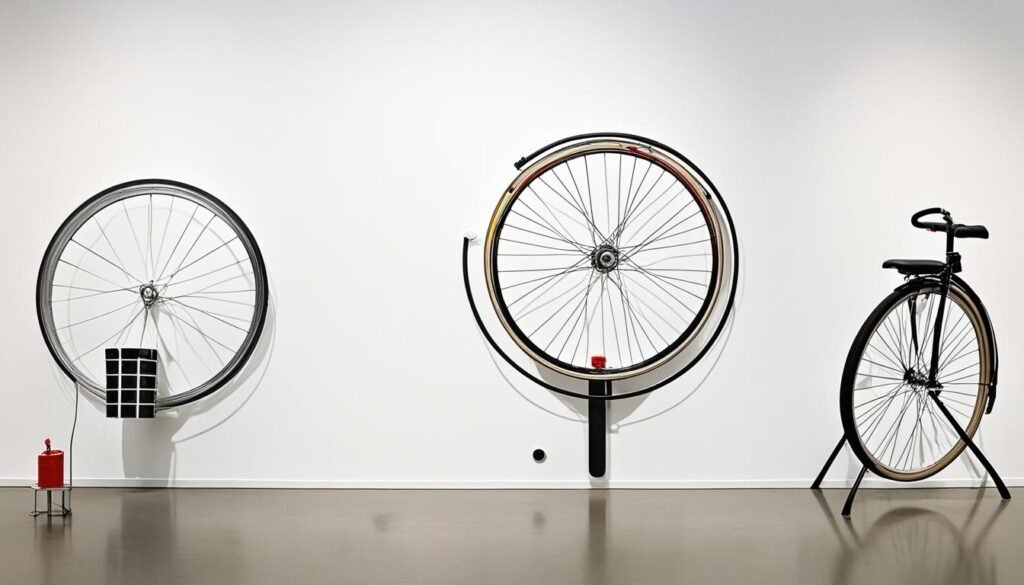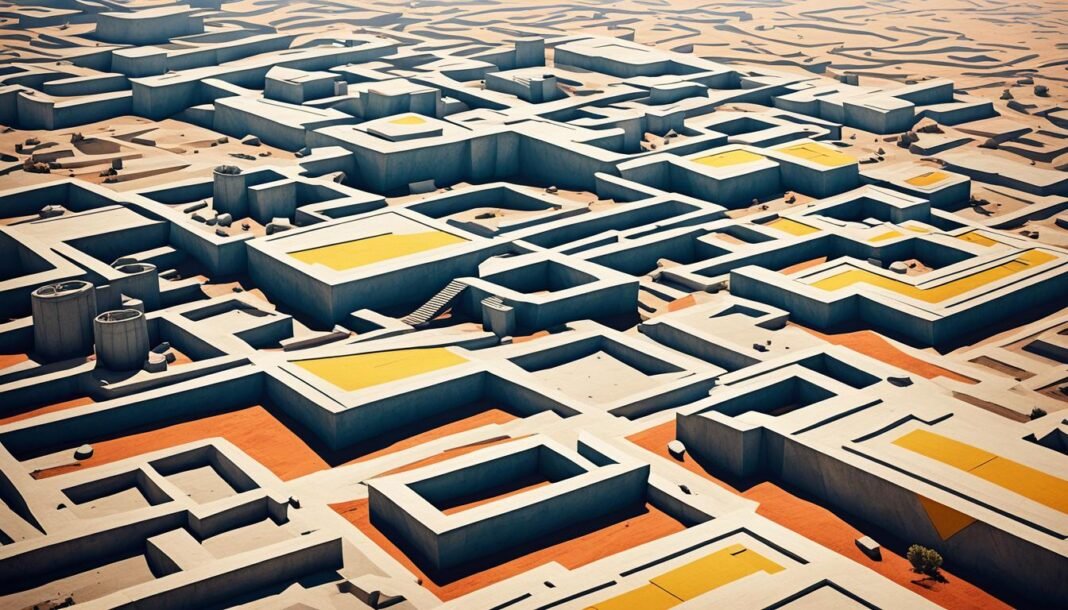Marcel Duchamp was a major figure in modern art, known for reshaping art’s boundaries. His idea of the wayward landscape duchamp introduces a modern art mystery. It sparks deep thoughts and discussions. Duchamp was the first to use ‘readymade’ art, turning everyday items into art. This move shifted focus from visual art to art that makes us think and feel. Exploring Duchamp’s mysterious works, we see his lasting impact on art movements like Dada and Surrealism. This journey is key to fully grasping his legacy.
For more insights into Marcel Duchamp’s remarkable impact on the art world, visit this link.
Key Takeaways
- Marcel Duchamp transformed the definition of art through his innovative use of ‘readymade’.
- The concept of a wayward landscape duchamp ignites exploration into the mysteries of modern art.
- Duchamp’s influence is deeply woven into both Dada and Surrealism movements.
- His works encourage viewers to engage with art on a more intellectual level.
- Duchamp’s legacy continues to inspire contemporary artists today.
The Enigmatic World of Marcel Duchamp
Marcel Duchamp changed the art world forever. He showed us a new kind of enigmatic art, pushing the boundaries beyond the normal. He wasn’t like others such as J.L. Austin, because he didn’t stick to the usual art scenes1. This freedom let his art break new ground, with a focus on everyday objects and themes of sexuality1.
One key moment for Duchamp was when he introduced “readymades”. These are ordinary things he turned into art. Take his “Fountain” for example – just a urinal, but it made people think about what art really is1. Thierry de Duve, an art expert, believes Duchamp’s message was: if anyone can be an artist, then anything can be art. This idea changed how we see art creation1.
Duchamp’s work requires us to look deeper. He mixed psychology and language in his art. This makes us consider how our own experiences and the broader world affect how we see his pieces. People keep talking about Duchamp’s work, even asking if its shock value still holds up today1.
Understanding the Modern Art Movement
The modern art movement marked a significant change in art. Artists started experimenting and expressing themselves more freely. This shift happened in the late 19th and early 20th centuries. It included movements like Impressionism, Futurism, and Surrealism. Artists like Marcel Duchamp pushed boundaries, exploring new ideas and mediums.
Modern art’s impact on culture is huge. It shook the norms, sparking discussions among the public and critics. For example, a debate on Quora about the dislike for modern art garnered many comments2. Some op-eds argue that modern art often lacks effort and originality2. These discussions show the ongoing debate about art’s role in society.
Modern art has evolved, blending with contemporary practices. It now includes postmodern art, using technology and various forms like collage and performance. This evolution raises debates on artistic value and creativity. As art moves forward, it challenges us to rethink our views on what makes art great.
| Art Movement | Characteristics | Cultural Impact |
|---|---|---|
| Impressionism | Focus on light and color, capturing fleeting moments | Highlighted a shift towards subjective experiences |
| Futurism | Emphasis on speed, technology, and modernity | Provoked thoughts on industrialization and urban life |
| Surrealism | Exploration of dreams and the unconscious | Challenged perceptions of reality and society |
Art movements have always created important conversations in art history. They show how artists like Duchamp are key to understanding our world’s complexity. Each movement brings out the cultural value of art, creating a rich story that grows over time.
Scholars and writers have been crucial in explaining these movements. Talks by respected art historians shed light on these subjects3. They help us appreciate the journey to today’s art scene.
Exploring Surrealism’s Influence on Duchamp
Surrealism shaped Marcel Duchamp’s art, tapping into the unconscious. It emerged in the 1920s, breaking free from rational limits. This matched Duchamp’s revolutionary art and readymades. Duchamp’s surrealist friends helped him add irony and fantasy, challenging usual art views.
Duchamp infused art with surprise and new methods. His piece, Nude Descending a Staircase, No. 2, was first rejected, then cheered globally. It shows how surrealism changed art. His Bicycle Wheel made viewers part of the art, a fresh take4.
Duchamp wove smell into his shows, altering how we sense art. He delved into art and erotica, vital in surrealism. Pieces like Female Fig Leaf question old art types with sexual tones, showing his edge. His mix of surrealism and new techniques set new art standards, inspiring others.
| Aspect | Duchamp’s Work | Surrealism Impact |
|---|---|---|
| Artistic Expression | Readymades challenged traditional art definitions | Emphasis on the unconscious and irrational |
| Audience Interaction | Bicycle Wheel as an interactive piece | Engages viewers as active participants |
| Thematic Exploration | Eroticism in works like Female Fig Leaf | Provoked thought on societal norms |
Duchamp’s art links surrealism with avant-garde, pushing creative and perception limits. His work stresses surrealism’s role and his impact on modern art5.
The Concept of ‘Readymade’ in Duchamp’s Work
Duchamp changed how we see art with his readymade art idea. He took everyday objects and called them art. This act made us question what art really is. His famous pieces, like ‘Fountain’ and ‘Bicycle Wheel’, make us think about who makes art and its place in society.
The original “Fountain” by Duchamp was lost soon after it was made. Now, we only know it through a photo by Alfred Stieglitz from 19176. This made people see Duchamp’s readymades in a new light and think about their purpose.
Today, Duchamp’s readymades critique how art is sold and valued. They make us think differently about creativity and change how we understand art.

Shows like Melissa Gordon’s “Mimetic Pleasures” bring up similar ideas. Gordon’s work mixes sculpture, photo, and painting in a unique way6. It shows how creation, life, and art are all connected.
Duchamp’s art keeps sparking conversations about what art is and its role. It stands as a key influence in contemporary art, driving discussions on the nature and aim of art in our lives.
Artistic Interpretation: The Role of Personal Experience
Artistic interpretation is closely linked with personal experience. It shows how an artist’s background affects their art. Duchamp’s work was influenced by literature and science, adding depth to his view on art. This mix encourages viewers to connect visually and emotionally, creating a shared understanding.
In contemporary art, the idea that personal views enhance understanding stands out. Artists like Duchamp make art that sparks reflection, making people see things differently. This exchange deepens conversations about art’s role in society.
Art invites us to bring our stories into how we see it. Duchamp’s pieces show art goes beyond beauty, reaching into thought-provoking areas. Artists encourage us to explore our own and the world’s truths together.
Grasping the depth of artistic interpretation shows the value of our experiences in enjoying art. The back-and-forth between an artist’s intent and our thoughts refreshes how art is seen, underlining Duchamp’s lasting impact.
“Art is not a mere reflection of reality, but a way to grasp its deeper meanings.” – Marcel Duchamp
| Artist | Influences | Impact on Artistic Interpretation |
|---|---|---|
| Marcel Duchamp | Literature, Science | Encouraged viewer engagement through subjective perspectives |
| Pablo Picasso | Cubism, African Art | Redefined visual representation and perception of reality |
| Paul Gauguin | Post-Impressionism | Explored spiritual and emotional dimensions in art |
This analysis highlights how personal experiences influence art creation and perception, continuing to stir modern artistic conversations7.
Wayward Lanscape Duchamp: An Artistic Examination
Duchamp’s work shows a blend of form, meaning, and how we see art. It explores his artistic style and the symbols in his art.
Duchamp’s Unique Aesthetic Approach
Duchamp changed how we appreciate beauty in art. He wanted people to think deeply, not just look. This new approach makes us think about life and creativity in new ways. Duchamp and Martins learned body casting from Ettore Salvatore, a talented sculptor8. His methods changed how stories are told in art, using different materials to express feelings.
The Symbolism Behind ‘Wayward Lanscape’
The term “wayward landscape” shows life’s unpredictable nature. It’s a symbol for our complex lives, drawing from Duchamp’s ideas about society. The life mask of Marcel Duchamp, made around 1945, shows this idea8. A triptych for “H(ieronymous) Duchamp” hints at painter Hieronymous Bosch’s work, adding depth to Duchamp’s art8. His art goes beyond simple images, asking us to think about who we are and how we see the world.
| Series | Year Created | Location | Number of Boxes |
|---|---|---|---|
| Series A | 1941, 1942-1949 | Paris, New York | 20 (numbered) |
| Series B | 1941, 1942-1954 | Paris, New York | 60-75 (unnumbered) |
| Series C | 1958 | Paris | 30 (unnumbered) |
| Series D | 1961 | Paris | 30 (unnumbered) |
| Series E | 1963 | Paris | 30 (unnumbered) |
| Series F | 1966 | Paris, Milan | 75 (unnumbered) |
| Series G | 1966-1971 | Paris, Milan | 47 (unnumbered) |
This table shows the different series Duchamp created. It helps us understand his artistic journey and the symbols in his work.
Contemporary Art and Its Connection to Duchamp
Marcel Duchamp’s ideas still shape today’s art world, giving new ways to see art. His use of ‘readymades’ changed how we define art. For example, his 1917 “Fountain,” a ceramic urinal, was voted the most influential modern art piece in 2004. This shows his big impact9.
Duchamp inspired many to explore themes in performance and installation art. His work pushed artists to rethink societal norms and art’s limits. Pop Art and Conceptual Art, for instance, grew from Duchamp’s bold questions about what art can be. His legacy is key to today’s artistic growth9.
Duchamp’s spirit is alive in today’s art. Artists today continue his conversation, exploring new materials and ideas. This shows how Duchamp still influences art, pushing it toward new horizons10.
| Aspects | Influence of Duchamp | Contemporary Practices |
|---|---|---|
| Challenging Norms | Established ‘readymades’ | Performance Art |
| Medium Exploration | Use of found objects | Installation Art |
| Aesthetic Philosophy | Conceptual Approaches | Mixed Media Works |
The Impact of Avant-Garde Techniques
Avant-garde techniques have changed the world of contemporary art. They’ve set new benchmarks for creativity and how we express ourselves. These methods make us rethink what art is and the artist’s role in society.
Duchamp’s unique art practices have paved the way for future movements. They inspire artists to experiment and break the rules.
The Role of Unconventional Artistic Expression
Unconventional artistic expression is getting more attention in art conversations today. It expands the art discussion, allowing for a wide range of experiences and views. Artists inspired by Duchamp showcase how art can go beyond regular materials and techniques, leading to significant impacts.
The impact of avant-garde movements is visible in many art forms, from paintings to performances. By building on Duchamp’s readymades, modern artists start conversations about society and what we expect from art. This movement doesn’t just open new paths for creativity.
It also makes art a crucial part of cultural talks. It shows how important Duchamp’s work is to the art world11.
Delving into Duchamp’s Readymades
Marcel Duchamp turned everyday items into high art with his readymades. He picked ordinary objects and made them art by deciding they were. The best-known example, “Fountain,” shows that any object can be art if seen in the right context. This idea didn’t just change art; it blurred the lines between art and real life.
Duchamp’s readymades sparked big debates about who creates art and how we interpret it. At the heart of his work was the question of what makes something art. His ideas helped people see art in a wider way. Other artists began using his approach of choosing and framing objects.
His bold moves made art critics and galleries rethink what art is. Duchamp’s thinking still influences artists today, pushing them to explore new ideas. The impact of Duchamp’s readymades keeps inspiring discussions on art’s role in society12.
Art History: Duchamp’s Legacy in Modern Art
Marcel Duchamp changed modern art forever. He made people see art in new ways. His idea of ‘readymades’ started conversations about what art is. Duchamp became well-known in the late fifties and sixties. He is still studied today5.
The Duchamp legacy still influences artists today. It can be seen in pop art, conceptual art, and postmodernism. Duchamp liked using wordplay and puns. His autobiography in 1963 shared his thoughts and creative ideas5. He also explored using smells in his art.
Duchamp inspired many artists like Alexander Calder. They share similar themes in their work. This shows Duchamp’s impact on how we perceive art10. Ideas from different artists come together, thanks to Duchamp.
Curators play a big role in showing how Duchamp changed art. For example, the Global Conceptualism show at the Queens Museum of Art. It shows how Duchamp’s ideas still matter13.
Duchamp’s unique approach to art made him a key figure in art history. He challenged old ideas and encouraged new thinking. Artists around the world continue to be inspired by him.
Visual Aesthetics and the Experience of Art
Marcel Duchamp changed how we see art, showing that it’s more than just looking. He taught us that the art experience involves thinking and feeling. This invites audiences to dive into the idea of beyond retinal art. People then see art differently, deepening their understanding and enjoyment.
Expanding Beyond the Retinal Experience
Duchamp’s ideas show that art starts conversations that go beyond what we see. It stirs emotions, thoughts, and connections that bring us closer to the art. This mix of views makes our experience with art richer, showing the value of different perspectives.
Looking into what makes art impactful, we find three key parts. These are the art itself, the feelings it brings out, and its beauty or elegance. Together, they shape how we individually connect with art.
| Element | Description |
|---|---|
| Vehicle | The form created during artistic creation, which influences perception. |
| Affects | The mental states like emotions and moods formed in response. |
| Aesthetic Qualities | Attributes like elegance and grandeur that represent the work’s highest points. |
In the end, Duchamp’s work helps us see art in all senses. Recognizing art’s many layers lets us have deeper discussions and thoughts about it141516.
The Importance of Curators in Exhibiting Duchamp’s Works
Curators are vital in presenting Duchamp’s works. They act as a bridge between the art and its viewers. Their knowledge helps deepen our appreciation of Duchamp’s complex art. They design exhibits that show his work in the big picture of art history, making it understandable for everyone.
For instance, “The Dream of the Museum” at the M+ Museum in Hong Kong displayed Duchamp’s artworks with modern artists. This showed how crucial curators are in picking and setting up artworks that shake up the usual art rules17. Experts like Doryun Chong led the exhibition, showing how their insights shape the stories told in Duchamp exhibits17.
Duchamp’s art has been seen in many different ways over the years. These views change how people see and understand his work. Putting chance elements and found objects in exhibits makes the experience better for viewers. This highlights how each curator’s vision is important in the art world18.
The conversation between how exhibits are made and their change over time shows Duchamp’s lasting impact. It encourages today’s artists and curators to try new ways of showing art. As the art scene grows, curators’ fresh ideas will keep Duchamp’s art lively and important.

Conclusion
Marcel Duchamp’s creative approach has deeply influenced modern art. He made artists and audiences see art in new ways. With his readymades and performances, like the famous “Fountain,” he broke the rules of what art could be1. His impact lives on as artists today delve into themes of sexuality, consciousness, and society that Duchamp first introduced58.
Duchamp’s legacy is not just a part of history. It shows us where modern art is heading. His work keeps conversations about creativity and perspective alive and interesting1. By continuing to examine his contributions, we see that Duchamp’s influence will keep challenging and motivating artists in the future.
FAQ
What is the significance of Marcel Duchamp in modern art?
How did Duchamp’s work influence the surrealism movement?
Can you explain the concept of ‘readymade’ art?
What role does personal experience play in Duchamp’s artistic interpretation?
How does the ‘wayward landscape’ relate to Duchamp’s art?
In what ways does contemporary art reflect Duchamp’s influence?
What are avant-garde techniques, and how did Duchamp contribute to their development?
Why are Duchamp’s readymades significant in art theory?
What is Duchamp’s legacy in modern art history?
How did Duchamp change the viewer’s experience of art?
What is the role of curators in presenting Duchamp’s works?
Source Links
- In Defense of Modern Art
- Art in its Time: Theories and Practices of Modern Aesthetics
- The Subliminal Seduction of Marcel Duchamp — SHELLEY LAKE
- Marcel Duchamp: The Art of Making Art in the Age of Mechanical Reproduction
- Repainting the Readymade
- Authority Freedom – Salmagundi Magazine
- Landscape Backdrop of Étant donnés
- Marcel Duchamp (1887 – 1968)
- George Baker: Picabia and Calder: A Trajectory | Calder Foundation
- The D-S Expedition: Part I | Roger Shattuck
- BENJAMIN PRITCHARD with Joseph Masheck
- Rewriting Conceptual Art
- Microsoft Word – TitlePage.docx
- Spatial Aesthetics. Art, Place and the Everyday
- DissFormatDec2SchumOGS



